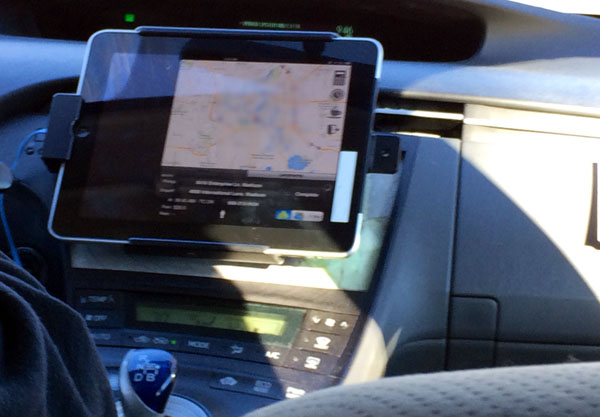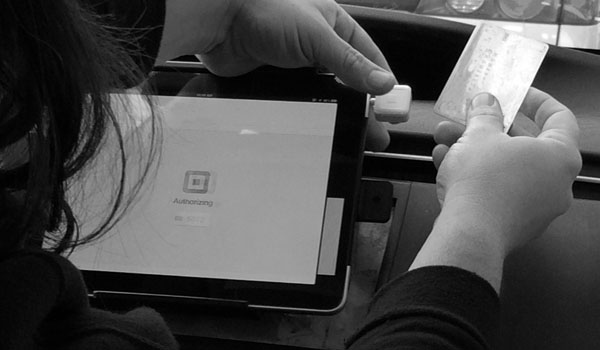But people love their cars. They have their stuff in their cars, the car seats for their baby, their Frisbees, their golf clubs—it’s their second home. People aren’t going to give that up, are they?
Ask a kid. Take teenagers 20 years ago and ask them would they rather have a car or a computer? And the answer would have been 100% of the time they’d rather have a car, because a car represents freedom, right?
Today, ask kids if they’d rather have a smartphone or a car if they had to pick and 100% would say smartphones. Because smartphones represent freedom. There’s a huge social behavior reorientation that’s already happening. And you can see it through that. And I’m not saying nobody can own cars. If people want to own cars, they can own cars. But there is a new generation coming where freedom is defined by “I can do anything I want, whenever I want. If I want a ride, I get a ride, but I don’t have to worry. I don’t have to make car payments. I don’t have to worry about insurance. I have complete flexibility.” That is freedom too.
Software, Geography & Communities
This is why location is becoming so much less important: technology is enabling us to access everything we need from our mobile phone, to find our true communities in the cloud, and to easily travel to assemble these communities in person. Taken together, we are rapidly approaching a future characterized by a totally new phenomenon, the reverse diaspora: one that starts out internationally distributed, finds each other online, and ends up physically concentrated.
What might these reverse diasporas be like? As a people whose primary bond is through the internet, many of their properties would not fit our pre-existing mental models. Unlike rugged individualists, these emigrants would be moving within or between nation states to become part of a community, not to strike out on their own. Unlike would-be revolutionaries, those migrating in this fashion would be doing so out of humility in their ability to change existing political systems. And unlike so-called secessionists, the specific site of physical concentration would be a matter of convenience, not passion; the geography incidental and not worth fighting over.
Report: Impact of Electric Vehicle Charging on Electric Grid Operations Could Be More Benign than Feared
Pecan Street Research Institute:
Electric vehicle (EV) owners are charging their cars much less during hot summer afternoons than most behavioral models predict.
That is one of the findings from a new PSR Analytics report that measured Summer 2013 vehicle charging in the nation’s highest residential concentration of electric cars. The analysis found that charging behavior is much more diverse than has been predicted, represents a much more manageable energy load and may be highly elastic to time-of-use pricing and similar tools.
If such findings are confirmed by other research, it could significantly increase utility industry estimates on the number of EVs the electric grid could handle without triggering disruptions or requiring major system upgrades.
PSR Analytics is produced by Texas-based energy research firm Pecan Street Research Institute. The institute’s electric vehicle research trial in Austin, Texas has what appears to be the highest U.S. concentration of electric vehicles, including over 50 in a single half-square mile neighborhood. The institute’s data-intensive research trials (currently in three states) has produced the world’s largest research database of residential energy use.
Over the Air Tesla Software a Update Removes a “a Smart Air Suspension” Feature
One of Tesla features is a $2,250 “smart air suspension” option that automatically lowers the car at highway speeds for better mileage and stability. Over a period of 5 weeks, three Tesla Model S cars had caught fire after severe accidents – two of them apparently from running over road debris that may have punctured the battery pack that made up the floor pan of the car. After the car fires Tesla pushed a software release out to its users. While the release notice highlighted new features in the release, nowhere did it describe that Tesla had unilaterally disabled a key part of the smart air suspension feature customers had purchased.
Only after most of Telsa customers installed the downgrade did Tesla’s CEO admit in a blog post, “…we have rolled out an over-the-air update to the air suspension that will result in greater ground clearance at highway speed.”
Translation – we disabled one of the features you thought you bought. (The CEO went on to say that another software update in January will give drivers back control of the feature.) The explanation of the nearly overnight removal of this feature was vague “…reducing the chances of underbody impact damage, not improving safety.” If it wasn’t about safety, why wasn’t it offered as a user-selected option? One could only guess the no notice and immediacy of the release had to do with the National Highway Safety Administration investigation of the Tesla Model S car fires.
via Steven Sinofsky.
Prius Taxi Economics


A recent Prius taxi ride offered a bit of data on fuel efficiency, durability and cost of ownership.
The kind driver mentioned that the Prius had 277,000 miles on it. “We replace the battery pack at 150,000 miles. They are expensive, about $5,000.00. “We average at least 41mpg and drive them hard. One Prius in our fleet has 350,000 miles on it. They cost about $28,000 new.”
It occurs to me that a diesel Golf, Jetta or Passat might be a better deal economically. I wonder if someone has done the math?
The Prius is certainly an interesting car and marketing initiative, but I do find them somewhat less “solid” than others.
A recent Asymcar podcast questioned why fleet owners have been slow to adopt non-traditional power systems.
Finally, I am constantly amazed at the places I find iPad apps used for line of business functions. The iOS wave continues to grow.
“Does Anyone Speak Czech On Board”?

Cruising at 35,000′ (10,668m), halfway into our eight hour journey, my finally, I think I am asleep slumber was interrupted by turbulence.
A flight attendant then began asking a passenger across the aisle to “get up”, “get up”, “Sir you must take your seat. The captain has illuminated the seat belt sign”.
I glanced to my right and was astonished to see a tall man lying on the floor, from one end of the 777’s bulkhead to another.
The flight attendant attempted to lift the passenger, without success. “OK, I will have to call the Captain“.
A number of flight attendants quickly congregated just in front of my somewhat cozy exit row seat. A large first aid suitcase appeared along with a defibrillator.
The lead flight attendant sought assistance: “Ladies & gentlemen, we have a medical situation and are looking for a doctor. Please ring your call button and we will find you.”
Two physicians appeared. The seasoned flight attendant asked for ID. The first doctor – well tanned from a vacation – said he did not carry a card. The flight attendant asked where he practiced and if he knew Dr. _____________. “He’s an opthamologist, right?”. “Yes, ok, you’re a doctor”.
The second doctor was an Army captain on his way to Afghanistan.
Three nurses appeared as well.
They quickly went to work, checking the sedate man’s vitals including his pulse, blood pressure and temperature.
More communication with the Captain.
The passenger and his wife spoke little English.
The medical volunteers decided to check next for diabetes. “Does anyone on board have a diabetes monitor?” (I have likely erred in the name of this device).
Two passengers appeared with their devices….
The medical team and flight crew were making little progress talking with the man’s wife. Soon, the lead flight attendant sought another volunteer “Does anyone on board speak Czech?”
The odds were loooooooooong, I thought, now standing to give the passenger assistance crowd more space.
Yes! A young Czech woman appeared. Communication happened. What were the odds?
90 minutes of flying time remained. The passenger was stable. We continued to jet east, seeking a sunrise.
More conversation with the Captain. We seemed to accelerate a bit. There would be no circling. Landing was prompt and foggy. I don’t recall such a direct approach on any previous flight.
All passengers were asked to stay seated while the paramedics walked on board and attended to the patient.
Remarkably, he walked off the plane with them….
I fondly recall this event as a wonderful example of human to human kindness. I did not observe any passenger grumbling, rather I enjoyed plenty of grace that recent night, at 35,000 feet.
Snap Out of It: Kids Aren’t Reliable Tech Predictors
I believe the children aren’t our future. Teach them well, but when it comes to determining the next big thing in tech, let’s not fall victim to the ridiculous idea that they lead the way.
Yes, I’m talking about Snapchat.
Last week my colleagues reported that Facebook recently offered $3 billion to acquire the company behind the hyper-popular messaging app. Stunningly, Evan Spiegel, Snapchat’s 23-year-old co-founder and CEO, rebuffed the offer.
Coming & Going on Facebook
Two-thirds of online American adults (67%) are Facebook users, making Facebook the dominant social networking site in this country.1 And new findings from the Pew Research Center’s Internet & American Life Project indicate there is considerable fluidity in the Facebook user population:
61% of current Facebook users say that at one time or another in the past they have voluntarily taken a break from using Facebook for a period of several weeks or more.
20% of the online adults who do not currently use Facebook say they once used the site but no longer do so.
8% of online adults who do not currently use Facebook are interested in becoming Facebook users in the future.
Extinguishing the tantrum cycle
Engaging in the middle of a tantrum does two things: it rewards the tantrum by giving it your attention, and it makes it likely that you’ll get caught up, and say or do something that, in the mind of the tantrum-thrower, justifies the tantrum. That’s the fuel the tantrum is looking for–we throw tantrums, hoping people will throw them back.
When you have valuable employees or customers (or kids) who throw tantrums, that might be a sign that there’s something wrong with your systems. The most basic way to decrease tantrums is to find the trigger moments and catch the tantrum before it starts. By creating a way for people to raise their hand, send a note, light a signal flare or otherwise highlight the problem (internal or external) before it leads to a tantrum, you can shortcircuit the meltdown without rewarding it.
Asymcar 7: The Transportationist
The Transportationist, David Levinson (@trnsprttnst) joins us to discuss the technical, human, environmental and economic factors driving change to the auto-ecosystem.